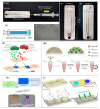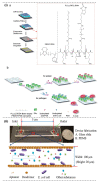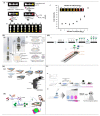Emerging Bioanalytical Devices and Platforms for Rapid Detection of Pathogens in Environmental Samples
- PMID: 35888900
- PMCID: PMC9321031
- DOI: 10.3390/mi13071083
Emerging Bioanalytical Devices and Platforms for Rapid Detection of Pathogens in Environmental Samples
Abstract
The development of robust bioanalytical devices and biosensors for infectious pathogens is progressing well with the advent of new materials, concepts, and technology. The progress is also stepping towards developing high throughput screening technologies that can quickly identify, differentiate, and determine the concentration of harmful pathogens, facilitating the decision-making process for their elimination and therapeutic interventions in large-scale operations. Recently, much effort has been focused on upgrading these analytical devices to an intelligent technological platform by integrating them with modern communication systems, such as the internet of things (IoT) and machine learning (ML), to expand their application horizon. This review outlines the recent development and applications of bioanalytical devices and biosensors to detect pathogenic microbes in environmental samples. First, the nature of the recent outbreaks of pathogenic microbes such as foodborne, waterborne, and airborne pathogens and microbial toxins are discussed to understand the severity of the problems. Next, the discussion focuses on the detection systems chronologically, starting with the conventional methods, advanced techniques, and emerging technologies, such as biosensors and other portable devices and detection platforms for pathogens. Finally, the progress on multiplex assays, wearable devices, and integration of smartphone technologies to facilitate pathogen detection systems for wider applications are highlighted.
Keywords: bioanalytical devices; biosensors; pathogens; responsive materials; smart materials.
Conflict of interest statement
The authors declare no conflict of interest.
Figures






References
Publication types
LinkOut - more resources
Full Text Sources
Molecular Biology Databases

